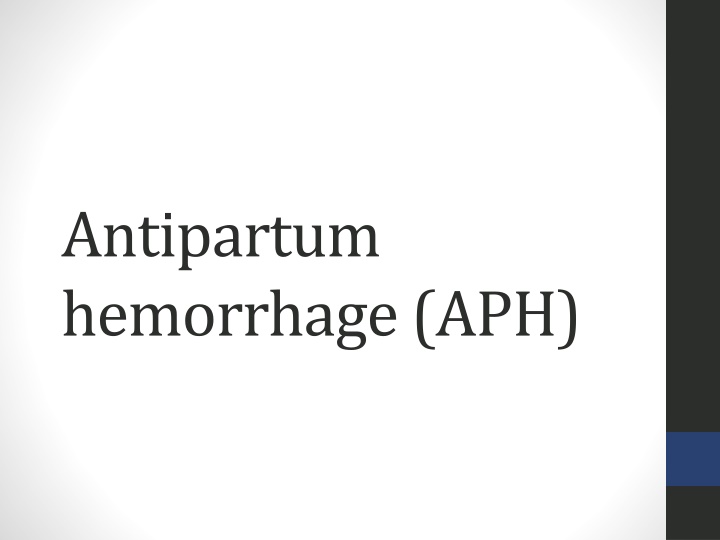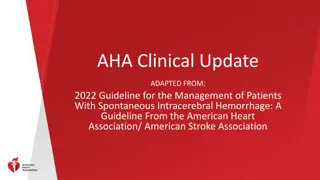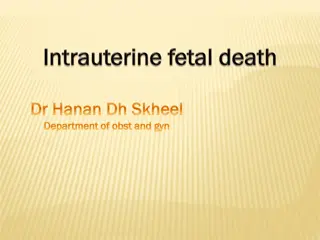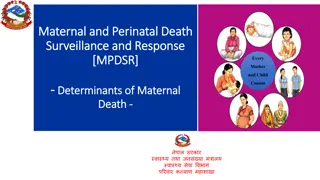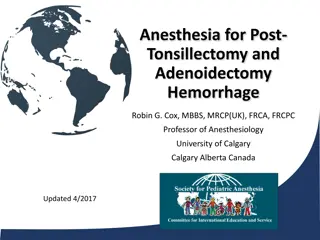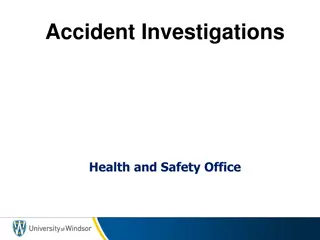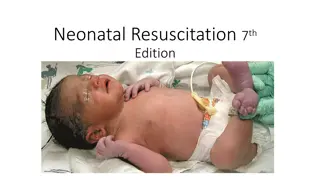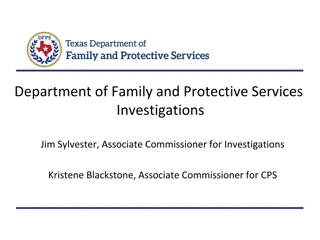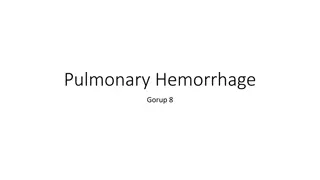Antepartum Hemorrhage: Causes, Management, and Investigations
Antepartum hemorrhage (APH) is a significant complication affecting pregnancies globally, with varying severity and causes such as placenta previa and abruption. Management involves a multidisciplinary approach in hospital maternity units, including resuscitation and emergency delivery. Investigations like CBC, RFT, and ultrasound are crucial for assessment. This condition poses a risk to both maternal and fetal health, highlighting the importance of prompt and comprehensive care.
Download Presentation

Please find below an Image/Link to download the presentation.
The content on the website is provided AS IS for your information and personal use only. It may not be sold, licensed, or shared on other websites without obtaining consent from the author.If you encounter any issues during the download, it is possible that the publisher has removed the file from their server.
You are allowed to download the files provided on this website for personal or commercial use, subject to the condition that they are used lawfully. All files are the property of their respective owners.
The content on the website is provided AS IS for your information and personal use only. It may not be sold, licensed, or shared on other websites without obtaining consent from the author.
E N D
Presentation Transcript
Antipartum hemorrhage (APH)
Bleeding from or into genital tract occurring from 24 weeks of pregnancy and prior to the birth of the baby. Affects 3-5% of pregnancies. It s the leading cause of maternal morbidity and prenatal mortality ( mainly due prematurity ) Obstetric hemorrhage remains one of the major causes of maternal death in the developing countries .
50% of estimated 500,000 maternal deaths occurring globally per year. Fifth of very preterm babies are born in association with APH. APH has a heterogeneous pathophysiology and can t be predicted.(70% of cases of abruptio placenta occur in low-risk pregnancies )
There is no consistent definition of the severity of APH(often underestimated) Following definitions have been used : 1-spotting: staining, streaking, spotting 2-minor hemorrhage <50 ml 3- major hemorrhage : 50-1000 ml with no signs of clinical shock 4- massive : more than 1000 ml and/or signs of clinical shock
Causes: 1-placenta previa 2-placenta abruption 3-local causes (cervical or vaginal lesions, cancer, infections or lacerations) 4-vasa previa 5-uterine rupture -unexplained (high risk pregnancy SGA, RRO.M, PTL, IUGR, C/S)
Management: in the hospital maternity unity with facilities for resuscitation such as: 1-anesthetic support 2-blood transfusion resources 3-performing emergency operative delivery 4-multi disciplinary team including: Midwifery, obstetric staff, neonatal staff, anesthetic staff, hematologist, radiologist and vascular surgeon.
Investigations: CBC, RFT, LFT, Coagulation factors, blood grouping, Rh. ABCD : A,B AIRWAY and breathing oxygen 10-15 L/min C: Circulation: two large bore cannulas . 14 gauge IV lines. D: asses fetus and decide delivery -Clinical Examinations -No vaginal digital examination ,speculum examination should be done to rule out local causes. u/s to diagnose placenta previa
Steroids can be given if pregnancy < 34 weeks for fetal lung maturity. Tocolysis shouldn t be used in (unstable patient, fetal compromise, major APH) It s a decision of a senior obstetrician . Avoid nifedipine (HYPOTENSION) Anti DIg should be given to all non sensitized RH-ve if they have APH. At least 500 IU antiDIg followed by a test of FMH if it's more than 40ml of RBC additional Anti D required. Anti D Ig should be given at minimum of 6 weeks intervals(in recurrent bleeding) Risk of PPH: pt should receive active management of 3rdstage of labor using syntometrine (in absence of high B.P) Senior consultant anesthetic care needed in high risk hemorrhage .
maternal -anemia -infection -maternal shock -renal.T.necrosis -DIC -PPH -prolonged hospital stay -psychological sequelae -Complications of b.t Fetal -hypoxia -SGA -IUGR -prematurity -fetal death
